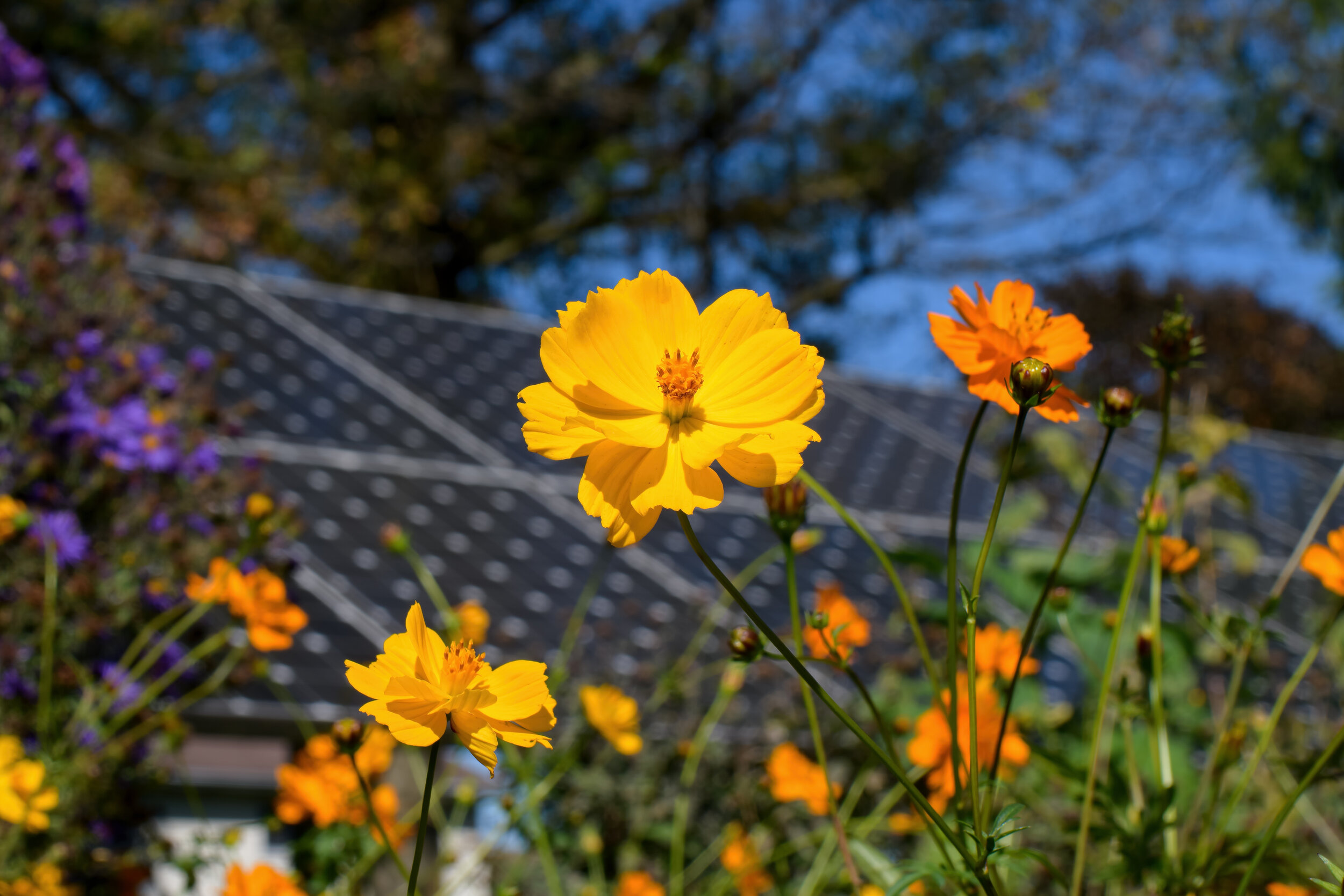
Solar and Birds
Smart Solar Siting and Bird Habitat
Songbirds have been on the decline for decades, and habitat loss is a major factor. Habitat loss is not just the removal of habitat, but includes edge effects and habitat isolation which both contribute to habitat fragmentation. Another factor which can have significant impact on birds is climate change. Stress on the bird population is exacerbated by the effects of warming temperatures and increased climate variability, which can also lead to habitat disruption. Kentucky’s large-scale solar industry has been growing rapidly—an industry that can impact large areas of open land even as it supports the reduction of greenhouse gases. How we manage the growth of this industry is an important conversation for habitat conservation.
.
Understanding Solar
Not all types of solar projects have the same impact on birds and wildlife.
The impacts of climate change are creating stress on many species, particularly birds. Climate change currently threatens more than 300 species (2/3rds of American birds) according to The Audubon Society. See their report “Survival by Degrees.”
So it is important to balance the impacts of large-scale solar vs. the impacts of climate change. With proper planning and more recent enhancements, solar photovoltaic farms can provide electricity without the carbon pollution that threatens these bird populations.
As the solar industry continues to grow and evolve, so does its interaction with nature. The technology that supports renewable energy development has been changing rapidly. As a result, much of the information that is available on the Internet can quickly become obsolete. It can also be confusing as to what exactly is being talked about as companies and constituents use new, unfamiliar terminologies. This can be the case when discussing the impact of solar arrays on birds.
We have often seen articles commonly found on the Internet that cite bird impacts without clearly distinguishing exactly which solar technology is involved. There is a tendency to conflate concentrated solar thermal power (CSP) which uses reflective mirrors that concentrate light and heat, vs. photovoltaic solar (PV) which absorbs light and does not generate heat. These two technologies can have vastly different impacts on birds.
The American Bird Conservancy’s 2014 position paper on birds and solar energy largely lumps CSP and PV technologies together, and in our opinion should be updated to more accurately reflect the distinction between the two forms of solar, and the different impacts. It has been clearly documented that concentrated solar power can be a threat to birds who fly into these concentrated beams of sunlight. However Solar PV technology is very different.
The Audubon Society’s more recent position paper on Solar Power and Birds accurately makes that distinction, concluding that CSP solar is too dangerous for birds, but Solar PV, when properly sited, is supported by the organization, and finds that climate change is the bigger threat. See their essay on “Why Solar Power is Good for Birds.”
What are the Issues?
How do solar installations impact birds? Here are some issues that are often raised.
The Avian Solar Working Group (ASWG) focused specifically on supporting research on utility-scale solar installations and their impact on birds. While the Group was initially formed to look at issues involving concentrated solar (CSP), the Group has more recently focused on Photovoltaic (PV) installations, which are commonly found in the East. Environmental groups in this coalition include Audubon, Natural Resources Defense Council, Defenders of Wildlife and The Nature Conservancy.
Collisions: ASWG supported the funding of studies that would answer critical questions on how renewable energy would interact with wildlife. One such study was to investigate the hypothesis of a “lake effect”— the theory that birds may confuse panels with water bodies, causing collisions. Biologists with Western EcoSystems Technology researched this theory, focusing on both water-dependent birds and birds that use land but often feed in water. Conclusions found limited evidence of attraction of aquatic habitat birds to the PV solar facility sites and no evidence of impacts from landing, circling or approaching, and that gathering of some aquatic birds may be similar to that of a wet parking lot.
In 2020, the US Department of Energy awarded Argonne National Laboratory $1.3 million to develop a “deep learning” system that can automatically monitor bird activity at solar facilities. More on this from Cleantechnica.
Glare: Solar PV panels are designed to absorb, not reflect, the sun. Most modern solar panels are designed with anti-reflective glass front surfaces. Drawing on several different studies, the National Renewable Energy Laboratory (NREL) has studied panels with and without anti-reflection coatings, and concluded that reflection of solar PV modules are negligible, similar to that of smooth water.
In KCC’s assessment, the primary impact to birds would be in managing habitat loss, which is why smart solar siting is the single most important consideration when building these facilities.
Sandhill Cranes: We have received several inquiries over developments near Sandhill Crane feeding areas around proposed solar projects in Hardin County. While we have no guidance specific to Kentucky, we are sharing guidance that Florida’s Department of Fish and Wildlife has published on solar and Sandhill Cranes:
“Cranes nest in wetlands but use open upland habitats for foraging and can be found using solar farms….Activities in the nesting season should be avoided within 400 feet of any active nests. While the young are flightless avoid any development of the site within 1500 feet of the wetland until after the young are capable of sustain flight. Proper siting of a solar farm should include making sure the boundary of the solar farm is at least 400 feet from any wetland that cranes may use……Sandhill cranes stand almost four feet tall and are known to peck at reflections. Solar panels installed low to the ground may encourage damage from cranes. If you are building a solar farm in an area where sandhill cranes are known to frequent, consider raising the infrastructure so that the front of the panels are at least four feet above the ground. Don’t plant turfgrass which can create an open habitat that encourage sandhill cranes to use the solar farm as a feeding ground. Consider planting herbaceous wildflowers for pollinators between solar panels to discourage cranes but improve pollinator habitat….”
Sensible Planning
Proper siting is essential for protecting habitat.
The Kentucky State Nature Preserves Commission has an online biological assessment tool to help identify specific biological data that citizens can use to identify sensitive areas. You may find the tool at this link.
Currently there are no major studies that address the impacts of large solar installations on bird migration paths.
Different avian species are likely to be affected differently by solar developments, dependent on the specific habitat within and around a solar PV development, the spatial requirements of a specific site (such as flocking species that require large areas to host the flock) and the foraging behavior of a given species.
Until further scientific evidence is accrued to support any positive or negative impacts of solar farms on bird migration paths, projects should be assessed on a site by site basis for habitat disruption.
Wildlands and Woodland General Considerations:
Unless sited on open land, brownfield, or previous development, large-scale solar projects can sometimes include clearing of wooded areas due to the sheer size of utility-scale solar.
As a result, habitats and ecosystems can be fragmented or disrupted. Below are the six principles of low impact solar siting and design courtesy of The Nature Conservancy:
Avoid areas of high native biodiversity and high-quality natural communities
Allow for wildlife connectivity, now and in the face of climate change
Preferentially use disturbed or degraded lands
Protect water quality and avoid erosion
Restore native vegetation and grasslands
Provide wildlife habitat
Best Practices:
PV sites should ideally be fenced to keep large carnivores out of the area and developers should be encouraged to add nesting boxes as part of the fencing plan and pollinator plantings. as part of the project.
See KCC’s page on Solar and Land Considerations for further guidance and other “best practices” such as integrating pollinator plantings.
Also see Audubon’s Birds and Transmission Report
Kentucky Birding Information and Helpful Weblinks:
National Birding Information and Helpful Weblinks:
Pollinator Resources:
Are Solar Farms Compatible with Biodiversity?
Some states like Ohio have developed a “Solar Site Pollinator Habitat Planning and Assessment” tool to rate the integration of solar developments with pollinator goals. This assessment tool was developed by the Ohio Pollinator Habitat Initiative which is a joint effort between the Ohio Dept. of Fish & Wildlife, US Fish & Wildlife, Ohio Dept. of Transportation and nonprofits.
These initiatives to integrate solar development with agriculture, pollinator habitat, and best management practices are becoming known as “Regenerative Energy,” “Agrophotovoltaics” or “Dual-Use Farming” initiatives. As this industry develops, we encourage companies to work with pollinator advocates in Kentucky to develop suitable “best practices.”



